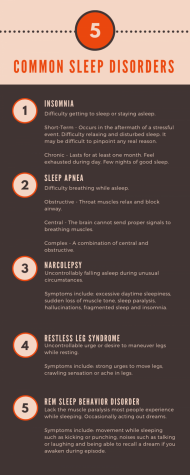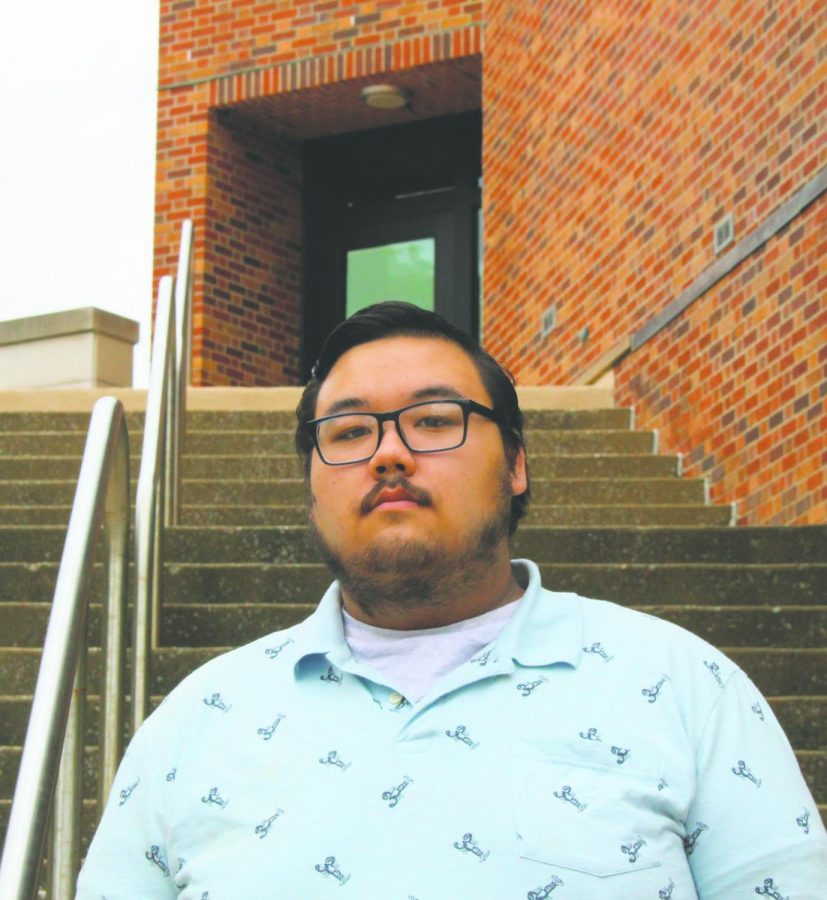Living with a sleep disorder
Sleep disorders often go unnoticed and may contribute to workplace incidents and lower grades
“If you are tired all the time, you may want to see a sleep doctor,” Brandon Visetchaisri, vocal music education junior, said.
October 17, 2018
For Brandon Visetchaisri, vocal music education junior, waking up for classes in the morning can be a struggle. It can take over
half an hour or more to wake up, and sometimes his headaches in the morning last from the moment he wakes up until sunset.
Up until the time he was graduating from high school, he had no idea that he had a problem and thought his sleepiness and migraines were normal. At a regular checkup in 2017, his doctor was checking his breathing and asked him if he snored a lot when he slept.
It was then that he decided to have a sleep study.
Visetchaisri was diagnosed with obstructive sleep apnea, a sleep disorder that occurs when breathing is obstructed during sleep. Symptoms include loud snoring, sleepiness or lack of energy during the day, sleepiness while driving, morning headaches and restless sleep.
“They woke me up one to two hours into the test and said that I stopped breathing a lot of times,” Visetchaisri said.
According to Mayo Clinic, there are three types of sleep apnea: obstructive sleep apnea, where the throat muscles relax and block the airway; central sleep apnea, where the brain cannot send the proper neurological signals to the muscles that control breathing; and complex sleep apnea syndrome, when someone has a combination of central and obstructive sleep apnea.
According to the National Sleep Foundation, it is estimated that more than 18 million American adults have obstructive sleep apnea and it occurs in all age groups and for both sexes.

Most people who have obstructive sleep apnea have no idea that they have it.
“My last year of high school was bad because I was falling asleep in class. I would snore so [loud], my friend was always like ‘wake up,’” Visetchaisri said. “Driving at night sucked too, I would almost fall asleep at the wheel.”
Sleep apnea is one of many sleep issues experienced by college students every day.
Sleep issues include sleep deprivation, shift work disorder, exceptional daytime sleepiness, or even sleep disorders such as dyssomnias, parasomnias and medical or psychological disorders.
“We often see cases of narcolepsy and insomnia for college students.” Tiffany Helmerich, family nurse practitioner at Expert Sleep Medicine, said. “Shift work sleep disorders and sleep deprivation are also very common.”
Health Risks and Treatments
Left untreated, obstructive sleep apnea can increase the risk of hypertension, cardiovascular disease and strokes.
“A lot of studies show that not treating sleep apnea can cause dementia,” Helmerich said.
According to the Journal of the American Geriatrics Society, there is a significant correlation between elderly patients with five or more respiratory disturbances per hour of sleep and those diagnosed with dementia.
Sleep disorders can have other health risks as well.
These risks include diabetes, irregular heartbeats, lower sex drive, depression and anxiety.
According to a study published by the American Diabetes Association, sleep disturbances are often linked to irregular heartbeats and diabetes.
Sleep disorders can also contribute to low testosterone and a low sex drive in adults.
According to Elsevier, in a study of patients with abnormal Epworth Sleepiness Scale scores, men with abnormal scores were more likely to have erectile dysfunction.
The Epworth Sleepiness Scale is a common tool used by sleep professionals to survey patients for sleep abnormalities which often involves patients answering a number of questions about their sleep at night.
According to an additional study published by Elsevier, in a study conducted on members of a large health maintenance organization in Michigan, prior sleep disorders such as insomnia are a significant predictor in subsequent major depression.
Chronic insomnia, which is the difficulty in falling asleep or staying asleep, is also a risk factor for the development of anxiety disorders, according to a 2007 study conducted by the Sleep Research Society.
“My sleep doctor said that sleep apnea was probably contributing to my health such as my blood pressure
and my stress levels,” Visetchaisri said.
Visetchaisri said his sleep doctor recommended that he be placed on a continuous positive airway pressure (CPAP) therapy treatment.
CPAP is a common treatment where a machine uses a hose and a mask to deliver constant air pressure, which prevents the airway from collapsing while asleep.
“We will also put people on BiPAP therapy,” Helmerich said. “It is similar to a CPAP machine, but it has different pressure settings for inhalation and exhalation.”
Visetchaisri’s treatment is focused on assisting with breathing, other kinds of treatment for common sleep disorders for college students include other approaches.
For short-term insomnia, decreasing workload, going to bed earlier, meditation or therapy may help to improve sleep at night.
Some are more complex to treat, such as narcolepsy, which may be attached to other neurological disorders and may require further tests to determine the cause.
“The healthy amount of sleep for young adults to get each night is seven to nine hours,” Helmerich said. “Not getting enough sleep can affect your immune system as well as your cardiovascular system.”
School and Workplace Performance
According to the Journal of American College Health, adverse effects from sleep disorders can include deficits in attention, drowsy driving, depression, risk-taking behavior or declines in academic performance.
“College is much harder than high school,” Visetchaisri said. “I think that if I didn’t get my CPAP that my grades would be lower.”
According to 2008 findings from the National Sleep Foundation in America, sleep disorders also affect both school and the workplace.
There is an increase in the likelihood of negative performance and occupational accidents.
There is also an increase in the likelihood of calling in to school or work.
“Sleep deprivation will make you feel drowsy during the day and can cause you to fall asleep during routine work and school activities,” Helmerich said. “Many young adults we see mention that they fall asleep during their classes and feel drowsy at their desks.”
In a study conducted by the Department of Psychology at the University of North Carolina in 2010, 27 percent of students were at risk for at least one sleep disorder.
Students at risk for sleep disorders were more likely to have a GPA lower than a 2.0.
“Delayed sleep phase syndrome is also a problem for college students,” Helmerich said. “That is when young adults will go to sleep two or more hours beyond what they should and have a hard time waking up in the mornings.”
Although Visetchaisri still has to manage symptoms of sleep apnea, he believes things have gotten better since he was diagnosed and placed on CPAP therapy.
“I usually feel pretty clear,” Visetchaisri said. “I feel much better than I used to. If you are tired all the time, you may want to see a sleep doctor.”


